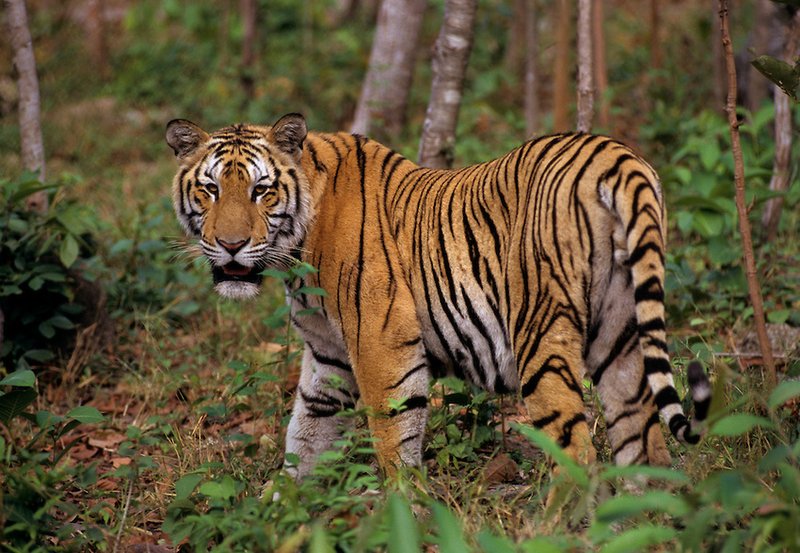
Now, you might be wondering why the Indochinese tiger is so special. Well, let’s take a closer look at its characteristics, behavior, and conservation status. Just like flipping through a fascinating book that you can’t put down, exploring these incredible facts about the Indochinese tiger will deepen your appreciation for one of nature’s most magnificent creatures.
1. The Distinctive Physique
One of the most striking features of the Indochinese tiger is its physical appearance. Unlike the larger Bengal tiger, the Indochinese tiger is generally smaller, with males typically weighing between 300 to 420 pounds. Their bodies are more slender, which helps them move swiftly through the dense forests they inhabit.
Their fur is also uniquely patterned. The stripes of the Indochinese tiger are narrow and closely set, creating a striking contrast against the vibrant orange coat. This unique pattern is not just for show; it helps them camouflage in their natural habitat, making it easier for them to hunt and avoid detection by humans and other predators.
2. Habitat and Distribution
The Indochinese tiger roams the forests, grasslands, and mountainous regions of Southeast Asia. You can find them in countries like Thailand, Vietnam, Cambodia, and Laos. Sadly, their habitat has been shrinking due to deforestation and human encroachment. This loss of territory forces these magnificent animals into closer contact with humans, increasing the risk of conflict.
These tigers are adaptable creatures. They can thrive in a variety of environments, but they prefer the tropical and subtropical forests where they can hunt for their favorite prey. With only an estimated 250 to 600 adults left in the wild, protecting their natural habitats is critical for their survival.
3. Diet and Hunting Techniques
If you think about the Indochinese tiger’s diet, it’s pretty fascinating how nature has equipped them to be such effective hunters. They primarily feast on deer, wild boar, and small mammals. These tigers are ambush predators, relying on their stealth and strength to bring down prey.
Here’s the thing: they can go for days without eating, depending on the availability of food. When they do hunt, they often rely on their keen senses and powerful legs to make a quick and decisive attack. It’s like they know when to strike, using the cover of trees and shrubs to get as close as possible before launching into action.
4. Social Behavior and Territory
You might be surprised to learn that Indochinese tigers are solitary animals. Unlike lions, which thrive in prides, most tigers prefer to live alone. Each tiger establishes its territory, which can span 20 to 80 square miles, depending on the availability of prey and the landscape.
When it comes to mating, however, they do come together. Female Indochinese tigers usually give birth to two to four cubs every two to three years. These cubs stay with their mother for about two years, learning essential survival skills before venturing out on their own. This independence is crucial because, in the wild, they need to be able to hunt and protect themselves.
5. Communication Methods
Tigers are fascinating communicators! They use a variety of sounds to express themselves, from low growls to loud roars, signaling their presence, warning off intruders, or calling for mates. Did you know that a tiger’s roar can be heard up to two miles away? It’s one of the loudest sounds in the animal kingdom, a formidable announcement that says, “I am here!”
In addition to vocalizations, Indochinese tigers also rely on body language and scent marking to communicate within their territory. They leave scratch marks on trees and deposit urine, which contains pheromones, to convey their presence to other tigers. It’s their version of leaving a note saying, “This area is taken!”
6. Conservation Status and Threats
Sadly, the Indochinese tiger is classified as endangered. The biggest threats they face come from habitat loss, poaching, and the illegal wildlife trade. As human activities encroach upon their habitats, these tigers find it harder to hunt and reproduce.
Conservation efforts are crucial to ensure their survival. Organizations and governments are working together to protect their habitats and combat poaching. You might be wondering, “What can I do to help?” Supporting wildlife organizations, spreading awareness, and promoting sustainable practices can make a difference. Every little action counts.
7. Cultural Significance
The Indochinese tiger holds a profound significance in the cultures of Southeast Asia. Many societies view tigers as symbols of strength, courage, and power. In some regions, they are even worshipped as deities, and their images appear in art, literature, and folklore.
This cultural reverence can play a role in conservation efforts, as communities that value tigers may be more inclined to protect them. Engaging local populations in conservation strategies can foster a sense of pride and responsibility, benefiting both the tigers and the communities.
8. Notable Individual Tigers
Every now and then, an individual tiger captures the public’s imagination. One such example is “Mali,” an Indochinese tiger known for living in a wildlife sanctuary in Thailand. Mali became a favorite among visitors not just for her beauty, but also for her playful interactions with caretakers. Stories like hers help humanize these majestic creatures and raise awareness about their plight.
Public figures and wildlife documentaries often highlight these notable tigers to promote conservation, reminding us that individual animals have stories worth telling. It’s these connections that can inspire action and change.
9. The Role of Indochinese Tigers in the Ecosystem
Every animal plays a role in its ecosystem, and the Indochinese tiger is no exception. As top predators, they help regulate prey populations. By keeping herbivore numbers in check, they maintain the balance of the ecosystem. Without tigers, deer and other prey species can become overpopulated, leading to overgrazing and the degradation of their habitat.
This balance is crucial not just for the animals but for the plants and other living organisms that make up the ecosystem. Protecting apex predators like the Indochinese tiger is essential for the health of the entire environment.
10. How You Can Make a Difference
You might be thinking, “What can I do to help the Indochinese tiger?” There are actually plenty of ways to contribute! Here are a few ideas:
- Support conservation organizations: Donating to reputable wildlife charities can help fund efforts to protect habitats and combat poaching.
- Spread awareness: Use your social media platforms to share information about tigers and their conservation status.
- Choose sustainable products: Be mindful of the products you buy. Supporting sustainable brands helps reduce habitat destruction.
- Educate yourself and others: The more you know, the more you can share. Knowledge is a powerful tool for change.
Exploring the world of the Indochinese tiger reveals just how remarkable and resilient these animals are, even in the face of adversity. They embody the wild beauty of Southeast Asia and play a vital role in their ecosystems. By understanding and appreciating them, we can all contribute to their survival.
Remember, every small action counts. Whether it’s sharing a fact with friends or supporting a conservation effort, you have the power to make a difference. Let’s work together to ensure that future generations can experience the awe of the Indochinese tiger in its natural habitat.

